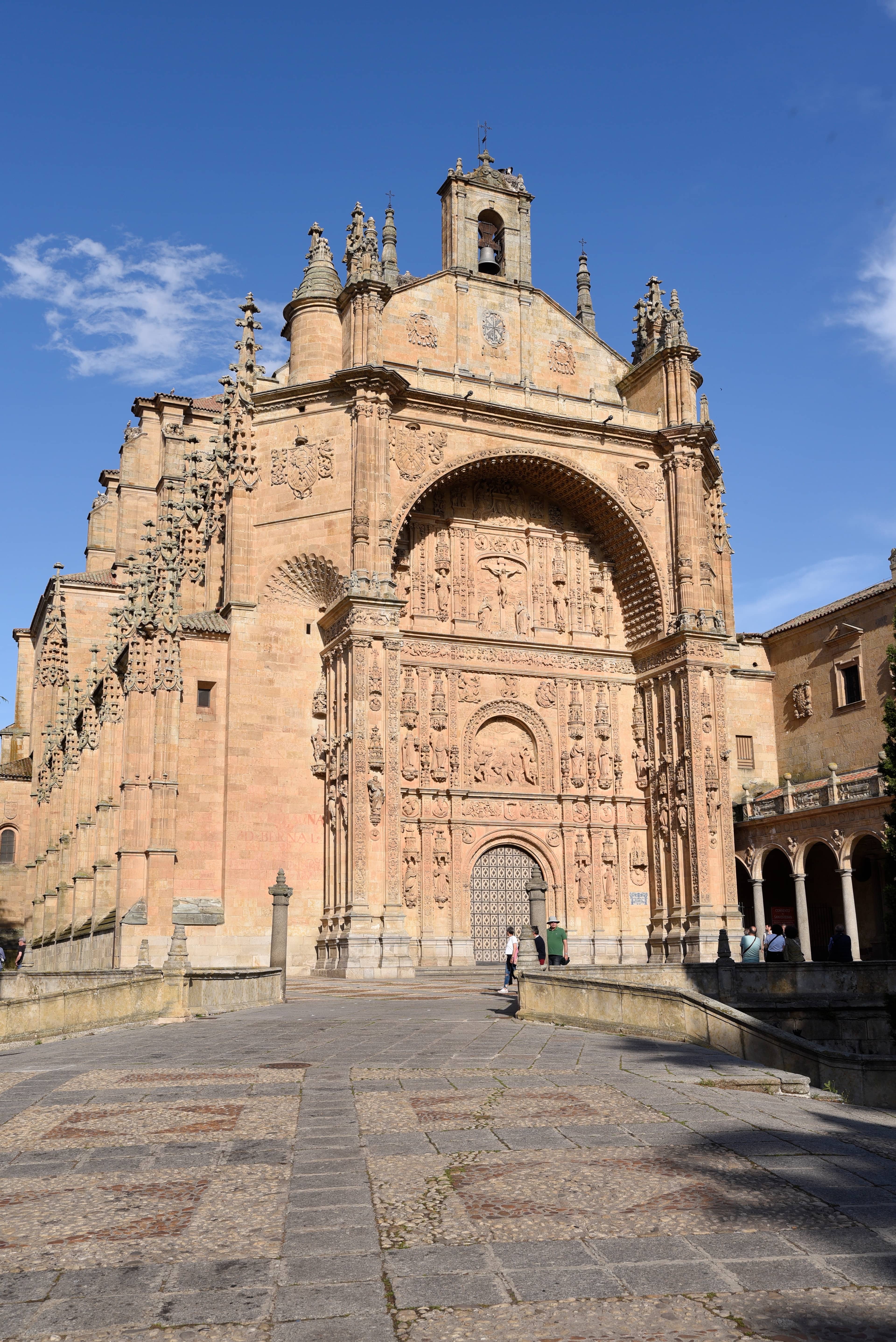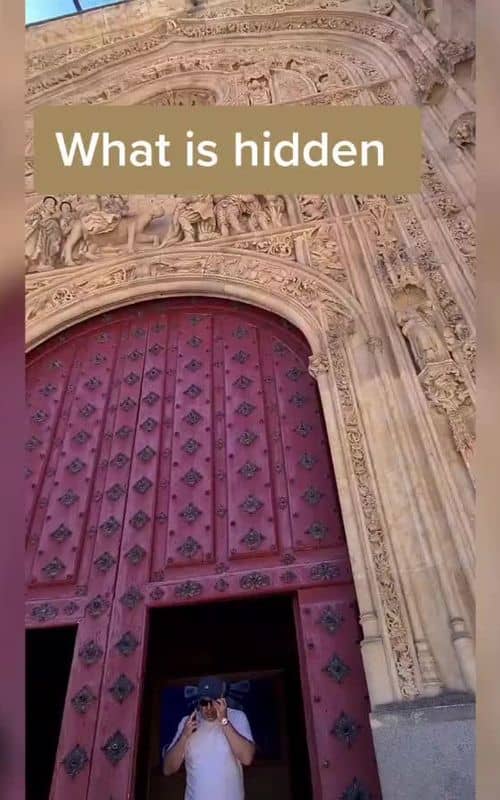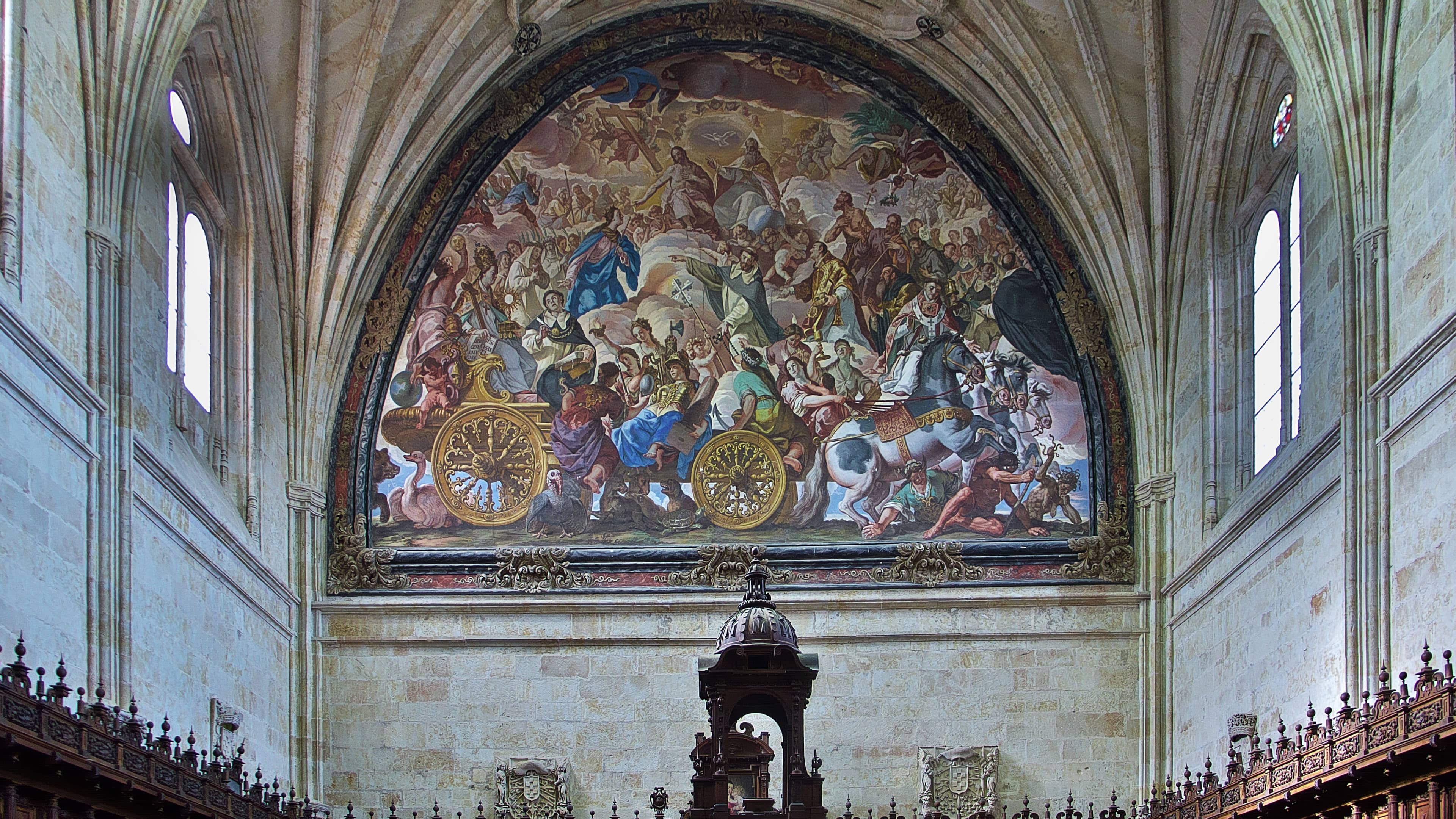
Convento de San Esteban Salamanca
Historic Dominican convent in Salamanca, renowned for its exquisite Plateresque facade and serene cloisters.

Highlights
Must-see attractions

Social
From TikTok & Reddit
Best Time
Fewer crowds, peaceful atmosphere

Convento de San Esteban Salamanca
Best Time
Fewer crowds, peaceful atmosphere

Highlights
Must-see attractions
Historic Dominican convent in Salamanca, renowned for its exquisite Plateresque facade and serene cloisters.
"A must-see for architecture, art, and history lovers, offering a peaceful vibe and stunning views."

Allow ample time
Dedicate at least 2 hours to explore every nook and cranny, from the crypt to the upper views. :stopwatch:
Admire the facade details
The golden stone and intricate carvings of the Plateresque facade are a must-see. :sparkles:

Highlights
Discover the most iconic attractions and experiences

Plateresque Facade
An exquisite example of Spanish Renaissance architecture, adorned with intricate stone carvings.

Cloisters
Central courtyard
Peaceful and serene, these historic cloisters offer a tranquil escape and stunning architectural details.

Crypt and Tombs
Lower levels
Discover the resting places of influential figures like the Duke of Alba and Francisco de Vitoria.

View from the Choir
Upper levels
Breathtaking panoramic views of Salamanca, especially stunning when the sun streams through.
Plans like a pro.
Thinks like you
Planning Your Visit
Timing is Key for Tranquility
Explore Beyond the Facade
Best Times
Insider Tips
from TikTok, Instagram & Reddit
Allow ample time
Dedicate at least 2 hours to explore every nook and cranny, from the crypt to the upper views. :stopwatch:
Admire the facade details
The golden stone and intricate carvings of the Plateresque facade are a must-see. :sparkles:
Peaceful cloisters
The central courtyard offers a serene escape and beautiful architectural views. :dove:
Historical significance
Learn about figures like Francisco de Vitoria and the Duke of Alba buried here. :scroll:
Tips
from all over the internet
Allow ample time
Dedicate at least 2 hours to explore every nook and cranny, from the crypt to the upper views. :stopwatch:
Admire the facade details
The golden stone and intricate carvings of the Plateresque facade are a must-see. :sparkles:
Peaceful cloisters
The central courtyard offers a serene escape and beautiful architectural views. :dove:
Historical significance
Learn about figures like Francisco de Vitoria and the Duke of Alba buried here. :scroll:
Stork spotting
Keep an eye out for storks nesting on the rooftops – a charming sight! :bird:
What Travellers Say
Reviews Summary
Visitors consistently praise the Convento de San Esteban for its stunning Plateresque architecture, peaceful cloisters, and rich historical significance. Many highlight the breathtaking views from the upper levels and the opportunity to explore at a leisurely pace. Some note that the admission fee is well worth the experience.
"A must if you are interested in architecture, art and history. The convent has a peaceful vibe. When we went, there were only 2 other visitors which made our visit even more memorable because it was easy to imagine how it was like when the religious personnel were living here.
We took more than 2 hours going from room to room, all the way to the top. We enjoyed looking at the details and taking it all in.
The courtyard at the centre was one of our highlights, and the view from the top was stunning. The sun shone from time to time, streaming through the open spaces and it felt quite magical."
Anna M
"The Convent of San Esteban is not merely a monument of stone and cloisters, but a resting place of history itself. Within its walls lie several illustrious figures of Spain’s intellectual and spiritual heritage, among them Francisco de Vitoria, whose pioneering work on the rights of the indigenous peoples of the Americas laid foundations for modern human rights. Alongside him rest other eminent Dominicans such as Domingo de Soto, Mancio de Corpus Christi, Pedro de Sotomayor, and Matías de Paz, each leaving their own mark upon theology and philosophy.
Yet what most captured my attention was the presence of Fernando Álvarez de Toledo, the formidable 3rd Duke of Alba. One of the greatest military commanders of his age, feared by his enemies and revered by his allies, his name alone evokes the discipline, power, and severity of Spain’s Golden Century. To stand in such proximity to his remains is to feel, if only briefly, the weight of empire and the echoes of a man who shaped history."
Q G
"An absolute must-see in Salamanca. It's very beautiful and interesting. The view from the choir is breathtaking and the cloisters are peaceful. We saw our first storks here too."
Lighthouse Tai Chi
What People Like
What People Dislike
Frequently Asked Questions
🚇 🗺️ Getting There
The Convento de San Esteban is centrally located in Salamanca, easily accessible on foot from most parts of the city. If arriving by bus or train, it's a short taxi or bus ride to the Plaza del Concilio de Trento. Many visitors find it a pleasant walk from the main university area.
Parking in the immediate vicinity of the convent can be challenging due to its central location. It's recommended to use public parking garages in Salamanca, such as the one near the Plaza Mayor, and then walk to the convent.
🎫 🎫 Tickets & Entry
Opening hours can vary, but generally, the convent is open daily. It's advisable to check the official website or local tourist information for the most up-to-date hours, especially around holidays.
There is an admission fee to enter the convent. Prices are generally reasonable, and it's worth checking for any potential discounts for students or seniors. Booking tickets in advance might be an option during peak season.
The convent complex includes the church, and typically a single ticket grants access to both. The church is open for worship on certain days and times, while the museum and cloister areas have specific visiting hours.
Photography is usually permitted inside the convent, but it's always a good idea to check for any specific restrictions, especially in areas with religious artifacts or during services. Drone photography is generally not allowed inside.
🎫 🏛️ Onsite Experience
The convent is a magnificent example of Plateresque and late-Gothic architecture, showcasing the characteristic golden stone of Salamanca and intricate Renaissance detailing.
Key attractions include the stunning Plateresque facade, the peaceful cloisters, the church, the crypts housing historical figures, and the views from the upper levels.
Most visitors recommend spending at least 2-3 hours to fully appreciate the architecture, history, and views. Rushing through can diminish the experience.
Guided tours may be available, offering deeper insights into the history and art of the convent. Inquire at the ticket office or check the official website for tour schedules and languages.
The convent has a rich history, including being a site for the autos de fe of the Inquisition in the 16th century and serving as a significant Dominican center since the 13th century.
🍽️ 🍽️ Food & Dining
Typically, there are no dining facilities directly within the convent itself. However, the surrounding Plaza del Concilio de Trento and nearby streets offer numerous cafes and restaurants serving local cuisine.
You can find traditional Castilian dishes, tapas, and local specialties in the restaurants around the convent. Look for places offering 'hornazo' or 'farinato' for an authentic taste of Salamanca.
📸 📸 Photography
The Plateresque facade, the central cloisters, and the views from the upper levels are prime photography spots. The golden stone of Salamanca also provides a beautiful backdrop.
Drone photography is generally not permitted within the convent grounds or for capturing close-up shots of the monument due to regulations and respect for the site.
For Different Travelers
Tailored advice for your travel style
👨👩👧 Families with Kids
Consider focusing on the more accessible parts of the convent, like the main cloister and the church. The historical figures buried here might be a bit abstract, but the sheer scale of the building and the views from the top can be exciting. Bringing a small notebook for them to sketch details or write down what they see can also enhance their engagement with the visit.
🏛️ Architecture & History Buffs
Delve into the convent's profound historical significance by exploring the crypts where figures like Francisco de Vitoria and the Duke of Alba are interred. Understanding the context of the Inquisition's autos de fe held here adds another layer to its complex past. Allow ample time to absorb the details of the cloisters and the narratives embedded within the stonework.
🚶 Solo Travelers & Contemplatives
Take your time to wander through the different sections, from the impressive facade to the upper viewpoints. The quietude of the convent provides an ideal setting for contemplation, allowing you to absorb the architectural beauty and the weight of centuries of history at your own pace. The views from the top offer a moment of quiet awe over the city.
Deep Dives
In-depth insights and expert knowledge
The Architectural Marvel: Plateresque Style
Visitors are particularly drawn to the main portal, which is a masterpiece of Plateresque art. It features a profusion of sculpted figures, coats of arms, and decorative patterns that create a visually stunning effect. The skill of the Renaissance artisans is evident in every detail, from the delicate tracery to the more robust sculptural elements. This facade is not just an entrance but a narrative carved in stone, telling stories of faith and history.
Beyond the facade, the cloister also showcases Plateresque elements, offering a more serene yet equally detailed architectural experience. The interplay of light and shadow within the cloister, combined with the intricate stonework, creates a tranquil and contemplative atmosphere. It's a space where one can truly appreciate the craftsmanship and artistic vision that went into the construction of the convent.
Echoes of History: Notable Figures and Events
The convent also bears witness to darker chapters of history. In the 16th century, it was a site for the autos de fe of the Spanish Inquisition, events that marked a significant and often somber period in Salamanca's past. These historical layers add a profound depth to the visitor experience, prompting reflection on the complex tapestry of human endeavor, faith, and power.
Founded in the 13th century by Dominican friars, the convent has been a center of religious and intellectual life for centuries. Its long history is intertwined with the development of the University of Salamanca, reflecting its enduring importance in the city's cultural and spiritual landscape.
Experiencing the Convent: Views and Atmosphere
A significant highlight for many is the view from the upper levels, particularly from the choir area. This vantage point offers breathtaking panoramic vistas of Salamanca, showcasing the city's iconic skyline. The way sunlight streams through the open spaces from these upper levels is described as 'magical,' enhancing the overall sensory experience and making the visit particularly memorable.
Allowing ample time is crucial to fully appreciate the convent. Visitors often spend more than two hours exploring from room to room, all the way to the top, taking in the details and the historical context. This unhurried approach allows for a deeper connection with the site, transforming a simple visit into a more immersive historical and architectural journey.



Social
from TikTok, Instagram & Reddit